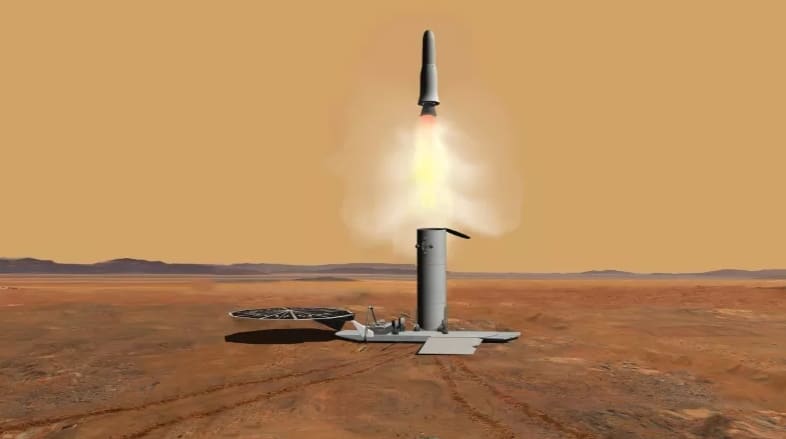
Earlier today, officials with NASA and the European Space Agency signed a statement of intent to explore the various ways in which Martian soil samples can be collected and delivered back to Earth. Sounds great, but a complex project of this nature won’t be easy, as it would involve the first-ever rocket launch from the surface of the Red Planet and a rendezvous in space.
The statement of intent was agreed upon today in Berlin by Thomas Zurbuchen, NASA’s associate administrator for the Science Mission Directorate, and David Parker, ESA’s director of human and robotic exploration. The document describes the potential role each space agency may take during the mission, and how each might contribute to the project.
We’ve already got rovers on the surface of Mars, including Curiosity, which has the ability to perform rudimentary chemical analyses of rocks and soil. It would be more ideal, however, to bring Martian soil samples back to Earth for a closer look. This way, scientists could conduct more detailed investigations of Martian dirt to study its chemical and (possibly) organic compounds. The results could be verified by other labs, and the soil could be continually tested as sampling techniques improve over time. NASA and ESA say such a mission would provide a “critical leap forward” in our understanding of Mars’ soil chemistry and prospects of habitability.
“A Mars sample return mission is a tantalising but achievable vision that lies at the intersection of many good reasons to explore space,” said Parker in statement. “There is no question that for a planetary scientist, the chance to bring pristine, carefully chosen samples of the Red Planet back to Earth for examination using the best facilities is a mouth-watering prospect. Reconstructing the history of Mars and answering questions of its past are only two areas of discovery that will be dramatically advanced by such a mission.”
Needless to say, this won’t be easy. It would be a technologically complex mission, involving three different launches from Earth, and with multiple points of potential failure from start to finish. Many details still need to be ironed out, but the project will consist of three overarching stages, some of which are already underway.
The first stage will involve NASA’s 2020 Mars rover. This probe will collect and pack the soil samples into about 30 pen-sized canisters, which it will plop onto the surface for later retrieval. For phase two, a second small rover will collect the canisters and deliver them to a Mars Ascent Vehicle—a small rocket that will deliver a shoebox-sized container to space. This container, with its soil samples packed inside it, will orbit Mars until the third and final stage of the mission. A third launch from Earth will send a spacecraft to Mars, where it will rendezvous with the container, scoop it up, place it into an Earth Entry Vehicle, and then head back home. Once at Earth, the spacecraft will make an atmospheric entry and land somewhere in the United States. The container will be retrieved, placed in quarantine, and finally analyzed by an international team of scientists.
Told you it’s not going to be easy. NASA and ESA are expected to present more details next year, after which time a decision will be made on if, how, and when to proceed.
Happily, some of the infrastructure required for this mission is already in place. As we mentioned, NASA’s 2020 Mars rover is definitely happening, but there’s also ESA’s ExoMars Orbiter to consider. This spacecraft only recently arrived at Mars, and it’s finally starting to send back images. In addition to measuring the atmospheric composition of Mars, the ExoMars satellite will act as a communications relay station for rovers on the ground. In addition, ESA’s ExoMars rover, which is expected to start digging deep into the Martian surface in 2021, could help scientists decide which samples should be stored and delivered to Earth.
